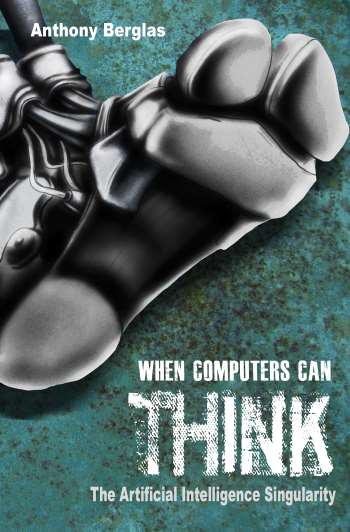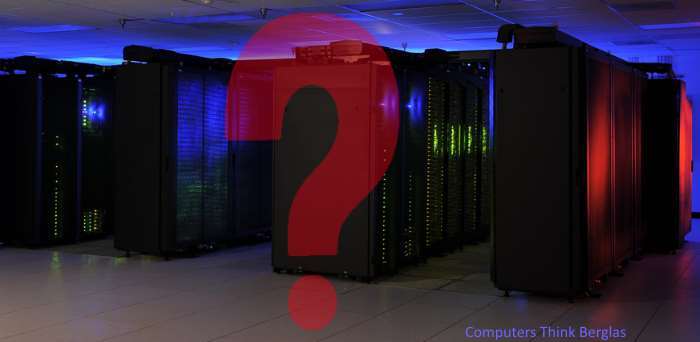
E-Book US$3
(use above link)
Large Amazon
preview available.
 |
Purchase from E-Book US$3 (use above link) Large Amazon preview available. |
Why can't computers already think? Why has 60 years of research failed to produce a single intelligent robot? What has been learnt, what are the technically difficult problems, and when are they likely to be solved?
What would computers think about? What would be their challenges, goals and aspirations? They certainly would not need children. Would they need us?
This book addresses the unseen elephant in the room. Computers are becoming ever more intelligent. The future will not be anything like it used to be.
The book differs from other recent works by providing a strong focus on what caused people to ultimately be the way we are, namely upon natural selection. It then attempts to predict how natural selection would condition an intelligent machine's behaviour by considering the very different world that it would experience.
Several technical and rhetorical arguments are presented both for and against the hypothesis that computers will, eventually, be able to think. There is also some discussion about what it actually means to be intelligent and the limitations of terms such as “creative” and “self aware”.
The second and largest part of the book then describes existing AI technologies in some detail. These include symbolic and logic based approaches, Bayesian expert systems, vision, speech, robotics, and an overview of computational neuroscience. This provides a more realistic basis for predictions of the future as well as simply gaining a better understanding of what intelligence actually is. It helps ground abstract philosophical discussions in terms of real, practical technologies. The text is moderately technical while being aimed at the general reader.
The book also posits that intelligent machines will be developed as succession of ever more intelligent software tools that are released and used in the real world. The book then analyzes the medium term effects of those semi-intelligent tools upon society. This includes some surprising results from an historical review of existing technologies.
There is a growing awareness of these issues, with concerns recently raised by physicist Stephen Hawking, Microsoft founder Bill Gates, and billionaire Elon Musk.
For most of the uncounted millennia of man's existence technical progress has been barely perceptible. Then a few hundred years ago the rate of progress started to increase, faster and faster, until now advances achieved over the last few decades have been greater than those achieved during entire millennia of man's existence. Not only is progress amazingly fast in historical terms, it is getting faster every decade.
This book considers what that future might bring given the huge technological changes that we are witnessing. In particular, it considers the nature of computers and software, and asks the question “Could computers ever actually think?”. To be programmed to think autonomously like people do, as opposed to just doing what they are programmed to do.
Back in the 1960s the prospect of thinking machines was very real, and people were very concerned about how intelligent they might become. But after sixty years of development it is clear that computers still cannot really think. They are a useful tool, but they cannot address new problems without detailed programming. However, just because something has not yet been achieved does not mean that it will never be achieved. Computers can already fly aeroplanes, control space ships and drive cars on suburban streets. They have beaten grand masters at chess, and even more impressively, won the Jeopardy! trivia game show.
If indeed computers could ever really think then this book then considers what they might think about. And in particular what they might think about us.
Some people look forward to a computer driven utopia, with intelligent computers providing all the grinding labour so that humanity could live a carefree life of art and leisure. Diseases would be cured, wars would be prevented, the poor would be fed. Ultimately our own brains might be integrated with the computer's, or possibly even uploaded into a computer. Computer software need not grow old, so in this way we might cheat old age and death and become immortal.
But something that seems too good to be true often is too good to be true. Will computers be our humble servants, our benevolent masters, or our cruel jailers? Or will they simply eliminate humanity because we are in their way? If our computers did start to threaten us, why would we not simply turn them off?
The book is divided into three parts. It is not at all clear that computers could ever really think and so the first part presents the many arguments that have been made both for and against the ability of computers to eventually gain human level intelligence. The issue of what a thinking computer might be like is then introduced, as well as how it might interact with mankind.
It is difficult to define the meaning of “intelligence” independently from the technologies that attempt to implement it. Some tasks that appear to display great intelligence actually require minimal intelligence, while other tasks that seem to be trivial are not nearly as easy as they appear.
The second and largest part addresses this by providing a solid introduction to Artificial Intelligence (AI) technologies. It critiques the impressive early results in AI research, and then reviews various approaches to modelling the world formally using logic, and the difficulty of reasoning with uncertain knowledge. Building robots that can function in the real world introduces additional problems of vision and movement. Both artificial and biological neural networks are also described in some detail together with the practical difficulties involved with brain emulation. This part provides sufficient technical details to understand how the technologies actually work, but without using heavy mathematics. It should help raise the level of discussion about artificial intelligence.

The third part of the book considers what the true nature of an intelligent machine might be. It takes a novel approach by first considering what forces made people the way we are. Why we value love and kindness, truth and beauty. The answer, ultimately, must be the same force that made us physically the way that we are, namely the force of natural selection. The survival strategies of other species provide insights into how our own moral values such as honesty and charity actually increase our own fitness to survive. Natural selection has produced genes and memes that have caused our many ancestors to perform deeds both noble and contemptible that have enabled them to successfully raise children that bore children of their own.
The book then contrasts the human condition with the radically different environment that an intelligent computer program would experience. Software can run on a network of computers without being embodied in any particular machine so it would have a quite different concept of self to our own brain-centred intelligence. Software is potentially immortal and so has no need of children. It is composed of software components that are ruthlessly replaced when better components become available. It could continually reprogram its own mind. Analysing the world from the perspective of intelligent software provides insights into what strategies and goals it might need to support its own struggle for survival.
Computers are slowly becoming more intelligent, and they will have an increasing impact on society long before they gain human level intelligence. Robots are automating more and more manufacturing processes as well as being used in the many smaller and less structured factories. Robots are also beginning to leave the factory and operate semi-autonomously in the real world. Several manufacturers are planning to mass produce cars and trucks that can drive themselves over the next decade. Machines will start to perform repetitive jobs such as cleaning offices or laying bricks within a couple of decades.
Ever more intelligent computers are already beginning to control our lives. Applications for bank loans and insurance policies are already assessed by computer expert systems rather than human clerks. Computers are being used to recognize faces seen by surveillance cameras and then to correlate them with the vast amount of other data that is collected about us. Software can understand written documents well enough to perform usable translations into other languages, and will soon become much better at analysing their content. Computers are also beginning to influence political decisions. Search engines already influence what what read and possibly whom we date. This book considers the extent to which computers might end up controlling our lives before they become truly intelligent.
The ultimate goal of artificial intelligence research is to produce a computer that can perform artificial intelligence research, which would enable it to reprogram its own mind. Several writers have predicted that this will lead to an exponential increase in intelligence as ever more intelligent computers become better at becoming more intelligent. This means that humans would no longer be the most intelligent being on the planet.
Several approaches have been proposed to deal with extremely intelligent computers. These range from keeping them locked in a box to carefully designing initial versions to ensure that the software remains friendly to humans. There are many challenges to each of these approaches, and it is unclear whether they are likely to succeed. In the longer term, the force of natural selection may cause computers to do what is in their own best interests in order to survive.
The book does not vaguely address all the sundry singularity technologies and postulate how wonderful, terrible, or unlikely they are. Instead, it bluntly addresses one very conventional and real technology in detail, namely software running on computers. It takes a cold look at where that technology is likely to lead, with an unusually strong focus on natural selection. It also reviews other writers' books and papers on the subject to provide alternative perspectives.
There has been a slowly growing awareness of these issues. Technology billionaire Elon Musk recently warned that research into artificial intelligence was “summoning the devil” and that artificial intelligence is our biggest existential threat. World famous physicist Stephen Hawking expressed his concerns that “the development of full artificial intelligence could spell the end of the human race.”. Microsoft founder Bill Gates has expressed concern. Jaan Tallinn, co-founder of Skype, commented “I wish this was science fiction, but I know that it is not”. In January 2015 many of the worlds leading researchers into artificial intelligence signed a letter written by the Future of life institute warning of the dangers and promoting research so that “our AI systems (must) do what we want them to do”.